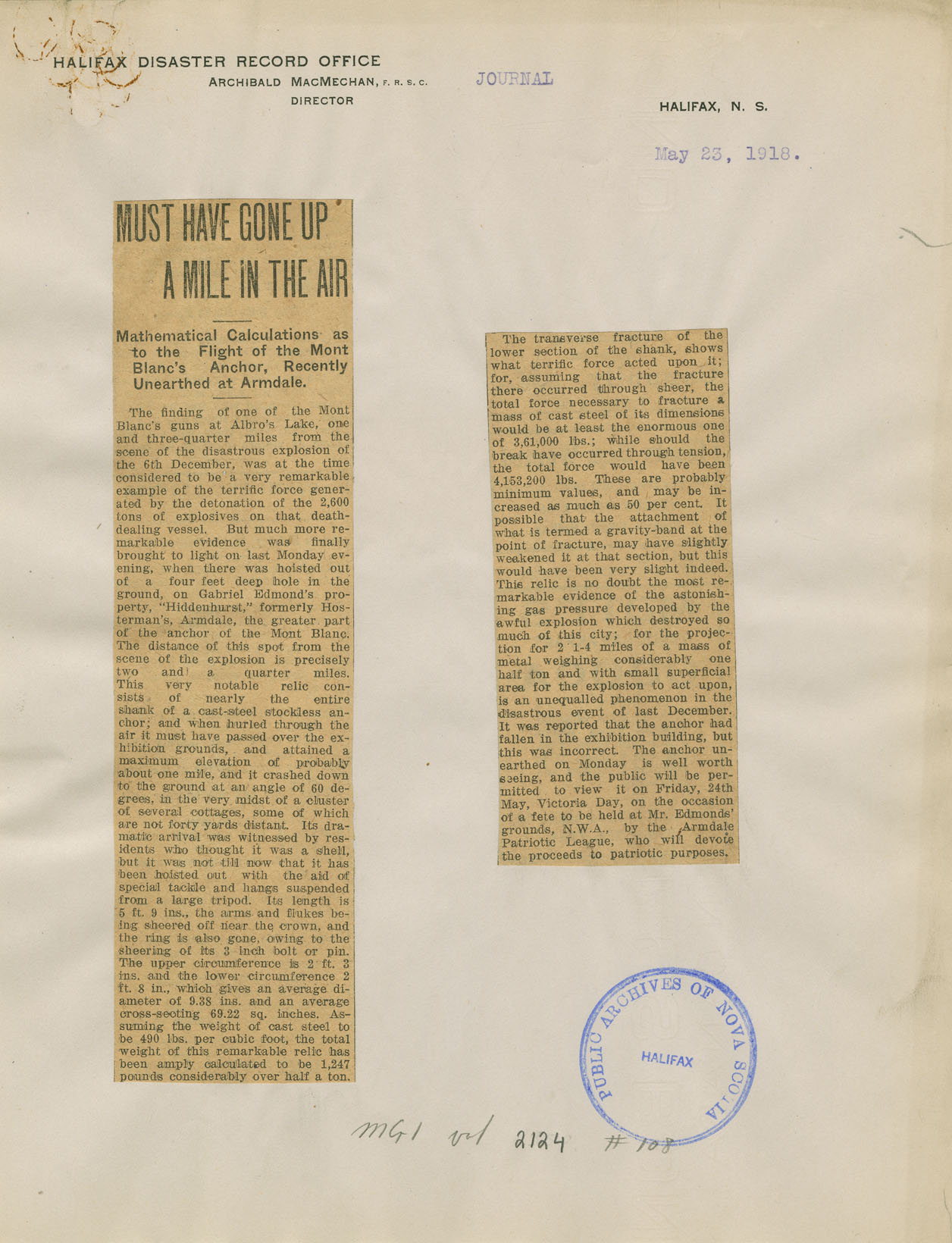Nova Scotia Archives
Archibald MacMechan
Halifax Disaster Record Office Materials
"Journal", clippings
23 May 1918. — 3 pages : 30 x 40 cm.
note: transcription publicly contributed - please contact us with comments, errors or omisions
HALIFAX DISASTER RECORD OFFICE
ARCHIBALD MACMECHAN, F.R.S.C.
DIRECTOR
HALIFAX, N.S.
May 23, 1918.
JOURNAL
[Newspaper clipping]
MUST HAVE GONE UP A MILE IN THE AIR
Mathematical Calculations as to the Flight of the Mont Blanc's Anchor, Recently Unearthed at Armdale.
The finding of one of the Mont Blanc's guns at Albro's Lake, one and three-quarter miles from the scene of the disastrous explosion of the 6th December, was at the time considered to be a very remarkable example of the terrific force generated by the detonation of the 2,600 tons of explosives on that death-dealing vessel. But much more remarkable evidence was finally brought to light on last Monday evening, when there was hoisted out of a four feet deep hole in the ground, on Gabriel Edmond's property, "Hiddenhurst," formerly Hosterman's, Armdale, the greater part of the anchor of the Mont Blanc. The distance of this spot from the scene of the explosion is precisely two and a quarter miles. This very notable relic consists of nearly the entire shank of a cast-steel stockless anchor; and when hurled through the air it must have passed over the exhibition grounds, and attained a maximum elevation of probably about one mile, and it crashed down to the ground at an angle of 60 degrees, in the very midst of a cluster of several cottages, some of which are not forty yards distant. Its dramatic arrival was witnessed by residents who thought it was a shell, but it was not till now that it has been hoisted out with the aid of special tackle and hangs suspended from a large tripod. Its length is 5 ft. 9 ins., the arms and flukes being sheered off near the crown, and the ring is also gone, owing to the sheering of its 3 inch bolt or pin.
The upper circumference is 2 ft. 3 ins. and the lower circumference 2 ft. 8 in., which gives an average diameter of 9.38 ins. and an average cross-secting 69.22 sq. inches. Assuming the weight of cast steel to be 490 libs. per cubic foot, the total weight of this remarkable relic has been amply calculated to be 1,247 pounds considerably over half a ton.
The transverse fracture of the lower section of the shank, shows what terrific force acted upon it; for, assuming that the fracture there occurred through sheer, the total force necessary to fracture a mass of cast steel of its dimensions would be at least the enormous one of 3,61,000 lbs. ; while should the break have occurred through tension, the total force would have been 4,153,200 lbs. These are probably minimum values, and may be increased as much as 50 per cent. It possible that the attachment of what is termed a gravity-band at the point of fracture, may have slightly weakened it at that section, but this would have been very slight indeed. This relic is no doubt the most remarkable evidence of the astonishing gas pressure developed by the awful explosion which destroyed so much of this city; for the projection for 2 1-4 miles of a mass of metal weighing considerably one half ton and with small superficial area for the explosion to act upon, is an unequalled phenomenon in the disastrous event of last December. It was reported that the anchor had fallen in the exhibition building, but this was incorrect. The anchor unearthed on Monday is well worth seeing, and the public will be permitted to view it on Friday, 24th May, Victoria Day, on the occasion of a fete to be held at Mr. Edmonds' grounds, N.W.A., by the Armdale Patriotic League, who will devote the proceeds to patriotic purposes.
PUBLIC ARCHIVES OF NOVA SCOTIA
HALIFAX
MG 1 volume 2124 number 108
Reference: Archibald MacMechan Nova Scotia Archives MG 1 volume 2124 number 108

